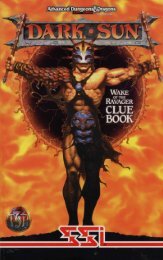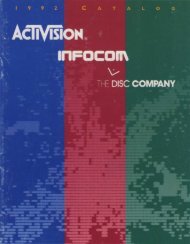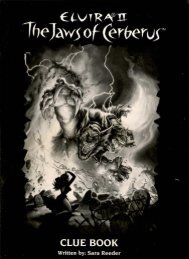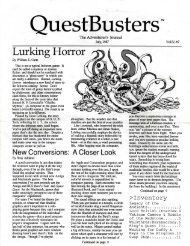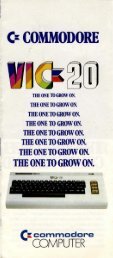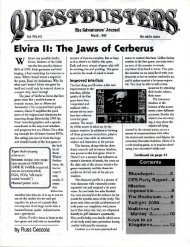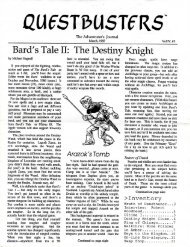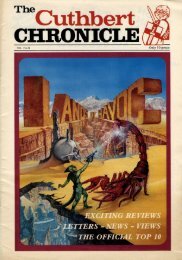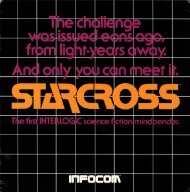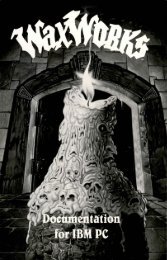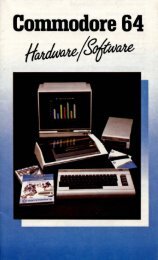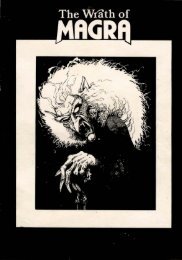mother of all quests! - Museum of Computer Adventure Game History
mother of all quests! - Museum of Computer Adventure Game History
mother of all quests! - Museum of Computer Adventure Game History
Create successful ePaper yourself
Turn your PDF publications into a flip-book with our unique Google optimized e-Paper software.
Ye Interface<br />
A glowing blue gem replaces the<br />
"game commands" function found in<br />
typical RPGs. You click on it to<br />
bring up the menu for saving, loading<br />
and so on, which makes you feel<br />
more like you're drawing on the<br />
powers <strong>of</strong> a magic orb than merely<br />
choosing a menu selection.<br />
You'll always see each character's<br />
number one factor — health —<br />
reflected in the color <strong>of</strong> a gem below<br />
his or her picture. Click on the<br />
character's face, and a full-screen<br />
picture shows icons and and numbers:<br />
a bulging muscle represents Might,<br />
with the number 17 beside it. Click<br />
each <strong>of</strong> the 64 map areas enjoys a<br />
unique look and feel, underscored<br />
dramatic<strong>all</strong>y by the variety <strong>of</strong><br />
imaginative monsters.<br />
Ranged spells and weapons are<br />
animated with flamboyant 3-D<br />
effects, like spir<strong>all</strong>ing orange and red<br />
flames. Deftly animated monsters<br />
abound, from the rampaging Scorpia<br />
monster to Skeletons that move like<br />
dancing death.<br />
Though the program was wholly<br />
redesigned, many elements <strong>of</strong> the<br />
magic system, presentation scheme<br />
and other facets still shine with a<br />
familiar gleam. The inner workings<br />
<strong>of</strong> the game, however, are so different<br />
that you cannot import a character<br />
created in previous games. But you<br />
can easily roll up and customize your<br />
own characters, as well as recruit<br />
NPCs, for a party <strong>of</strong> up to eight.<br />
and undwarved.<br />
Even then the isles <strong>of</strong> Terra were<br />
portrayed with brilliant 256-color<br />
graphics and distinct details that<br />
Ye VGA version<br />
bestow genuine personality on the<br />
people, monsters and places they<br />
represent. From the town <strong>of</strong> Fountain<br />
Head to the Cathedral <strong>of</strong> Carnage,<br />
By Shay Addams<br />
Inside thepre-alpha dungeon<br />
A month ago, New World started<br />
sending pre-alpha copies <strong>of</strong> the game<br />
to QuestBusters, where I've been<br />
playing regularly updated versions as<br />
its myriad pieces are intricately fit<br />
into place. On my first visit, I found a<br />
freshly created world filled with<br />
monsters but still unpeopled, unelved<br />
Major changes in gameplay<br />
"Designing it on the IBM opened<br />
up worlds we're just beginning to<br />
tap," van Caneghem emphasizes.<br />
"The major change in game play is<br />
the 'what you see is what you find'<br />
approach. In previous games, you just<br />
stepped on squares and events<br />
occurred. Now you see everything<br />
that's in the game in the 3-D window:<br />
if there's an altar in the room, you'll<br />
see it (...and when you kill something,<br />
it stays dead. No leaving the room<br />
and returning to kill the same monster<br />
or find the same treasure.)<br />
"That changes Might & Magic<br />
from a kind <strong>of</strong> text-based numbers<br />
game to an interactive graphics game.<br />
You don't have scores <strong>of</strong> numbers and<br />
messages: instead <strong>of</strong> just reading that<br />
'50 monsters attack,1 you'll see <strong>all</strong> the<br />
monsters in the 3-D window."<br />
Besides lots <strong>of</strong> monsters, you'll face<br />
another <strong>of</strong> those maddening end game<br />
puzzles for which van Caneghem's<br />
<strong>quests</strong> are famous. "In fact," he says,<br />
"lots <strong>of</strong> those kinds <strong>of</strong> puzzles are<br />
found throughout the game.<br />
"But they're much simpler. And<br />
previously the clues were scattered<br />
around so much that some people<br />
never found enough <strong>of</strong> them to figure<br />
out the puzzles. These are more<br />
centralized, so you can find <strong>all</strong> the<br />
clues to 'puzzle x1 in the same maze."<br />
You talk with NPCs via menu and<br />
button options, and the conversation<br />
appears in a large text window. Some<br />
puzzles ask you to type in a<br />
codeword, for instance, but dialogue<br />
isn't emphasized as in an Ultima.<br />
the main events." With the game's<br />
growing complexity, the number <strong>of</strong><br />
people working on Might and Magic<br />
has doubled since //. "Mark Caldwell<br />
is our key programmer, who's making<br />
it <strong>all</strong> work.<br />
began switching over from the eightbit<br />
mindset in the areas <strong>of</strong><br />
programming, art and game design."<br />
First came the new technology.<br />
"This was the first Might & Magic<br />
specific<strong>all</strong>y designed for the IBM,<br />
VGA and sound, and it has digitized<br />
speech, different sounds for each<br />
monster, 256-color graphics, an icon<br />
interface—even the conception <strong>of</strong> this<br />
kind <strong>of</strong> product would be impossible<br />
on an eight-bit machine. Unpacked,<br />
it's over five megs." (The first M &<br />
Ms were written on the Apple.)<br />
Next he dreamed up the general<br />
story and drew the first maps around<br />
it "I designed the story and maps and<br />
events," he elaborates, "like 'the<br />
wizard will be here with a scroll you<br />
can deliver to someone in town three,<br />
who'll give you 1,000 gold.' I write<br />
that on the map and in my notes,<br />
which I give to one <strong>of</strong> our writers to<br />
turn into game text. He adds <strong>all</strong> the<br />
lively adjectives and so on.<br />
"All the sub-events are then<br />
invented around the maps, and the<br />
fine details are added as we're playing<br />
Type: Fantasy Role-playing<br />
System: MSDOS (640K and<br />
hard disk required, mouse<br />
recommended; VGA, EGA;<br />
Roland, Ad Lib, Sound Blaster,<br />
Tandy 3-voice & DAC)<br />
Planned conversions; Amiga<br />
All-new technology<br />
"It has taken about a year to<br />
develop Might & Magic III" van<br />
Caneghem recollects, "from when we<br />
jj o you thought you killed Sheltem<br />
at the end <strong>of</strong> M & M III Well, says<br />
author Jon van Caneghem, "that was<br />
just a hologram <strong>of</strong> Sheltem." Sheltem<br />
is back in Isles <strong>of</strong> Terra, and so is<br />
Corak, whose soul you may have<br />
reunited with his body in M & MII.<br />
Believe me when I say there is no<br />
Don Ho on these islands, where in<br />
pursuit <strong>of</strong> the legend <strong>of</strong> Terra's<br />
creation, you must collect the clues<br />
Corak scattered across nearly every<br />
area <strong>of</strong> the planet's thirteen isles.<br />
Eventu<strong>all</strong>y you'll catch up with him<br />
to defeat Sheltem (hopefully not<br />
another hologram this time!). The<br />
story is far from linear, for you can<br />
start in the middle <strong>of</strong> the path, or skip<br />
some <strong>of</strong> the clues.<br />
The Making <strong>of</strong> Might & Magic HI: Isles <strong>of</strong> Terra



